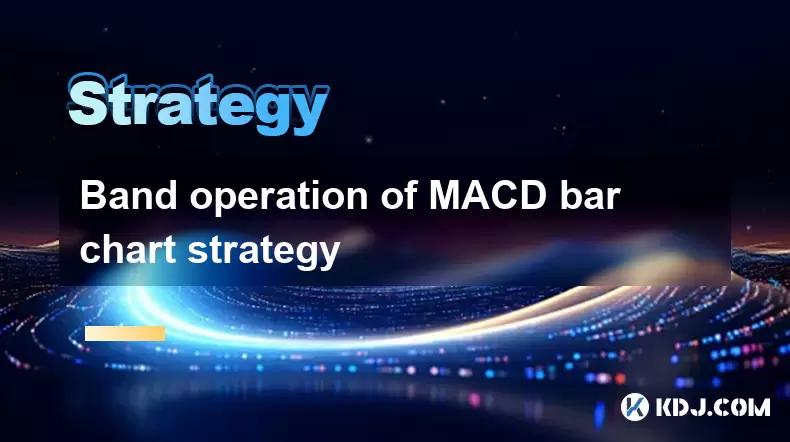-
 bitcoin
bitcoin $114779.865156 USD
2.30% -
 ethereum
ethereum $4226.519789 USD
2.39% -
 tether
tether $1.000545 USD
0.04% -
 xrp
xrp $2.890223 USD
0.92% -
 bnb
bnb $1030.029301 USD
2.95% -
 solana
solana $212.824944 USD
1.69% -
 usd-coin
usd-coin $0.999757 USD
0.01% -
 dogecoin
dogecoin $0.234961 USD
-0.27% -
 tron
tron $0.337174 USD
0.42% -
 cardano
cardano $0.804783 USD
0.09% -
 hyperliquid
hyperliquid $45.748770 USD
-2.85% -
 chainlink
chainlink $21.699170 USD
0.82% -
 ethena-usde
ethena-usde $1.001452 USD
0.08% -
 avalanche
avalanche $30.237800 USD
1.14% -
 stellar
stellar $0.372604 USD
1.52%
Band operation of MACD bar chart strategy
The MACD bar chart strategy uses band operations to help traders identify optimal entry and exit points in the crypto market, enhancing trading decisions.
Jun 07, 2025 at 03:28 am

The Moving Average Convergence Divergence (MACD) is a popular technical indicator used by traders in the cryptocurrency market to gauge momentum and potential trend reversals. When combined with a bar chart strategy, the MACD can offer valuable insights into the best times to enter or exit trades. This article explores the band operation of the MACD bar chart strategy, providing a detailed guide on how to effectively use this approach in your trading activities.
Understanding MACD and Bar Charts
Before delving into the band operation strategy, it's crucial to understand the basics of MACD and bar charts. MACD is calculated by subtracting the 26-day Exponential Moving Average (EMA) from the 12-day EMA. The result of this calculation is the MACD line. A 9-day EMA of the MACD line, called the signal line, is then plotted on top of the MACD line, which can help traders identify potential buy or sell signals. Bar charts, on the other hand, display the open, high, low, and close prices for each period, providing a visual representation of price movements.
Setting Up the MACD Bar Chart Strategy
To effectively implement the band operation of the MACD bar chart strategy, traders must first set up their trading platform with the necessary indicators. Here’s how you can do it:
- Open your trading platform and navigate to the chart section for the cryptocurrency you wish to analyze.
- Add the MACD indicator to your chart. Most platforms allow you to customize the settings, so ensure the standard settings (12, 26, 9) are used unless you have a specific reason to alter them.
- Add a bar chart to your chart if it isn’t already the default. Ensure that the time frame of the bar chart aligns with your trading strategy, whether it be daily, hourly, or another interval.
Identifying Entry and Exit Points
The core of the band operation strategy revolves around identifying the right moments to enter and exit trades based on the interaction between the MACD and the bar chart. Here's how you can do it:
- Look for crossovers: A bullish signal occurs when the MACD line crosses above the signal line, suggesting a potential buy opportunity. Conversely, a bearish signal is generated when the MACD line crosses below the signal line, indicating a potential sell point.
- Confirm with bar chart patterns: After identifying a crossover, confirm the signal by examining the bar chart. For instance, if you see a bullish crossover, look for bullish patterns such as a bullish engulfing or a piercing line on the bar chart to confirm the entry.
- Divergence analysis: Sometimes, the price movement on the bar chart and the MACD can diverge, which can be a powerful signal. If the price is making new highs but the MACD is not, it might be a sign of weakening momentum and a potential reversal.
Implementing Band Operations
The term 'band operation' in this strategy refers to setting up bands around the MACD line and signal line to help traders better time their entries and exits. Here’s how to set it up:
- Add upper and lower bands to the MACD indicator. These bands can be set at a fixed distance from the MACD line or signal line, or they can be based on the standard deviation of the MACD values.
- Use the bands to refine entry and exit points: When the MACD line moves above the upper band, it can be considered an overbought signal, suggesting a potential sell or short opportunity. Conversely, when the MACD line falls below the lower band, it can be seen as an oversold signal, indicating a potential buy or long opportunity.
- Monitor the interaction between the MACD and the bands: The key is to watch how the MACD line and signal line interact with these bands. A move outside the bands followed by a move back inside can signal a potential reversal.
Practical Example of Band Operation Strategy
To illustrate the band operation of the MACD bar chart strategy, let’s consider a hypothetical scenario with Bitcoin (BTC). Suppose you are monitoring the daily chart of BTC/USD.
- You notice that the MACD line crosses above the signal line, indicating a bullish crossover.
- You then look at the bar chart and see a bullish engulfing pattern, confirming the bullish signal from the MACD.
- You decide to enter a long position on BTC.
- You set up upper and lower bands on the MACD at a distance of two standard deviations from the MACD line.
- The MACD line moves above the upper band, suggesting that BTC might be overbought.
- You consider exiting your long position or taking profits as the MACD line moves back inside the upper band.
Fine-Tuning the Strategy
While the band operation of the MACD bar chart strategy can be effective, it’s important to fine-tune it according to your trading style and risk tolerance. Here are some tips:
- Adjust the band settings: Experiment with different distances for the upper and lower bands to find what works best for your trading style.
- Combine with other indicators: Consider using additional indicators such as the Relative Strength Index (RSI) or Bollinger Bands to confirm signals from the MACD and bar chart.
- Backtest your strategy: Use historical data to backtest the strategy and see how it would have performed in different market conditions. This can help you refine your entry and exit rules.
Managing Risk
No trading strategy is complete without a robust risk management plan. Here are some key considerations for managing risk when using the band operation of the MACD bar chart strategy:
- Set stop-loss orders: Always set a stop-loss order to limit potential losses. The placement of the stop-loss can be based on recent swing lows or highs, or a fixed percentage of your trading capital.
- Position sizing: Determine the size of your position based on your overall trading capital and risk tolerance. A common rule of thumb is to risk no more than 1-2% of your trading capital on any single trade.
- Monitor market conditions: Keep an eye on broader market conditions and news events that could impact the cryptocurrency you are trading. Be prepared to adjust your strategy or exit trades if necessary.
FAQs
Q1: Can the band operation of the MACD bar chart strategy be used for short-term trading?Yes, the strategy can be adapted for short-term trading by using shorter time frames on the bar chart, such as hourly or 15-minute intervals. Adjust the MACD settings accordingly, such as using a 5, 10, and 3-day EMA, to better suit short-term trading dynamics.
Q2: How do I know if the bands are set correctly for the MACD?The correct setting for the bands depends on your trading style and the volatility of the cryptocurrency you are trading. Start with a standard deviation of two and adjust based on backtesting results and your trading performance. Monitor how the MACD interacts with the bands over time to refine your settings.
Q3: Is it necessary to use the bar chart in conjunction with the MACD, or can I use the MACD alone?While the MACD can be used alone, combining it with a bar chart provides additional context and confirmation of signals. The bar chart helps you visualize price action and patterns, which can enhance the reliability of MACD signals.
Q4: How can I avoid false signals when using the band operation strategy?To avoid false signals, always confirm MACD crossovers with patterns on the bar chart. Additionally, consider using other indicators like the RSI to validate the signals. Be patient and wait for clear signals rather than jumping into trades based on ambiguous indications.
Disclaimer:info@kdj.com
The information provided is not trading advice. kdj.com does not assume any responsibility for any investments made based on the information provided in this article. Cryptocurrencies are highly volatile and it is highly recommended that you invest with caution after thorough research!
If you believe that the content used on this website infringes your copyright, please contact us immediately (info@kdj.com) and we will delete it promptly.
- BlockDAG, DOGE, HYPE Sponsorship: Crypto Trends Shaping 2025
- 2025-10-01 00:25:13
- Deutsche Börse and Circle: A StableCoin Adoption Powerhouse in Europe
- 2025-10-01 00:25:13
- BlockDAG's Presale Buzz: Is It the Crypto to Watch in October 2025?
- 2025-10-01 00:30:13
- Bitcoin, Crypto, and IQ: When Genius Meets Digital Gold?
- 2025-10-01 00:30:13
- Stablecoins, American Innovation, and Wallet Tokens: The Next Frontier
- 2025-10-01 00:35:12
- NBU, Coins, and Crypto in Ukraine: A New Yorker's Take
- 2025-10-01 00:45:14
Related knowledge

Practical parameter settings for a Bitcoin multi-timeframe moving average system
Sep 18,2025 at 10:54pm
Optimizing Timeframe Combinations for Bitcoin Trading1. Selecting appropriate timeframes is crucial when building a multi-timeframe moving average sys...

How can I filter out false breakouts in Dogecoin high-frequency trading?
Sep 22,2025 at 01:00am
Understanding False Breakouts in Dogecoin Trading1. A false breakout occurs when Dogecoin's price appears to move beyond a defined support or resistan...

Techniques for identifying tops and bottoms in the Bitcoin on-chain NVT model
Sep 20,2025 at 07:54pm
Understanding the NVT Model in Bitcoin Analysis1. The Network Value to Transactions (NVT) ratio is often described as the 'P/E ratio' of the cryptocur...

What does the surge in open interest in Bitcoincoin futures mean?
Sep 20,2025 at 11:18pm
Understanding the Surge in Dogecoin Futures Open Interest1. A surge in open interest within Dogecoin futures indicates a growing number of active cont...

How can I use the Ethereum USDT premium to gauge market sentiment?
Sep 18,2025 at 11:55pm
Understanding the Ethereum USDT Premium1. The Ethereum USDT premium refers to the price difference between USDT (Tether) traded on Ethereum-based plat...

What should I do if Ethereum staking yields decline?
Sep 20,2025 at 06:18am
Understanding the Causes Behind Declining Ethereum Staking Yields1. The Ethereum network transitioned to a proof-of-stake consensus mechanism with the...

Practical parameter settings for a Bitcoin multi-timeframe moving average system
Sep 18,2025 at 10:54pm
Optimizing Timeframe Combinations for Bitcoin Trading1. Selecting appropriate timeframes is crucial when building a multi-timeframe moving average sys...

How can I filter out false breakouts in Dogecoin high-frequency trading?
Sep 22,2025 at 01:00am
Understanding False Breakouts in Dogecoin Trading1. A false breakout occurs when Dogecoin's price appears to move beyond a defined support or resistan...

Techniques for identifying tops and bottoms in the Bitcoin on-chain NVT model
Sep 20,2025 at 07:54pm
Understanding the NVT Model in Bitcoin Analysis1. The Network Value to Transactions (NVT) ratio is often described as the 'P/E ratio' of the cryptocur...

What does the surge in open interest in Bitcoincoin futures mean?
Sep 20,2025 at 11:18pm
Understanding the Surge in Dogecoin Futures Open Interest1. A surge in open interest within Dogecoin futures indicates a growing number of active cont...

How can I use the Ethereum USDT premium to gauge market sentiment?
Sep 18,2025 at 11:55pm
Understanding the Ethereum USDT Premium1. The Ethereum USDT premium refers to the price difference between USDT (Tether) traded on Ethereum-based plat...

What should I do if Ethereum staking yields decline?
Sep 20,2025 at 06:18am
Understanding the Causes Behind Declining Ethereum Staking Yields1. The Ethereum network transitioned to a proof-of-stake consensus mechanism with the...
See all articles










































































